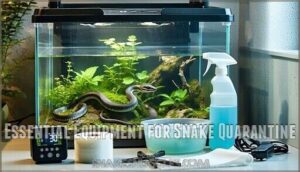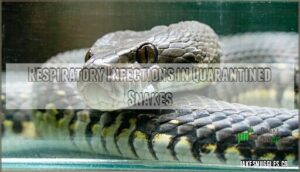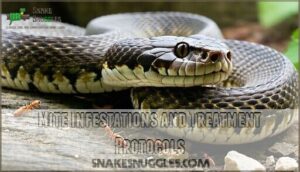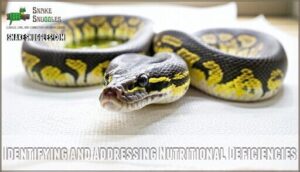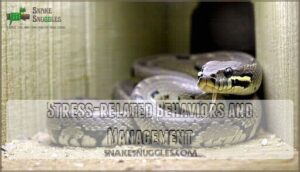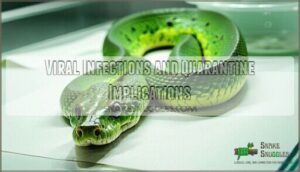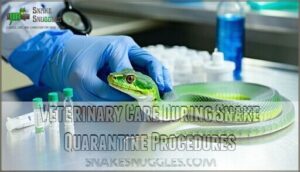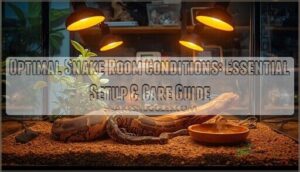This site is supported by our readers. We may earn a commission, at no cost to you, if you purchase through links.

Set up dedicated quarantine enclosures with easy-to-clean materials and use separate tools for each snake.
Monitor daily for respiratory issues, mites, unusual behavior, or feeding problems. Schedule fecal testing within the first two weeks to catch parasites early.
Keep detailed health records and maintain proper temperature and humidity throughout the quarantine period.
Snake health quarantine procedures aren’t just about playing it safe—they’re your collection’s insurance policy against costly outbreaks. The devil’s in the details regarding execution, and it’s crucial for preventing costly outbreaks and ensuring the health of your snakes, which is why these procedures are not just about playing it safe.
Table Of Contents
- Key Takeaways
- Importance of Snake Quarantine Procedures
- Setting Up an Effective Snake Quarantine Area
- Duration and Stages of Snake Quarantine
- Common Health Issues Detected During Snake Quarantine
- Veterinary Care During Snake Quarantine Procedures
- Post-Quarantine Integration of New Snakes
- Frequently Asked Questions (FAQs)
- Do you have a good reptile quarantine procedure?
- Should you quarantine snake mites?
- How long should wild-caught reptiles be quarantined?
- Why is quarantine important?
- What are the biosecurity measures for a quarantined animal?
- What equipment does a quarantined animal need?
- How do you quarantine a snake?
- How long until you can handle a snake after eating?
- How long to quarantine a snake with mites?
- What are the quarantine procedures for zoos?
- Conclusion
Key Takeaways
- Isolate new snakes for 60-90 days in a completely separate room – You’ll prevent disease transmission to your existing collection by maintaining strict physical separation and using dedicated equipment for quarantined animals.
- Monitor daily for health issues and get fecal testing done early – You’ll catch respiratory problems, mites, parasites, and behavioral changes before they become serious threats to your snake’s health or spread to other animals.
- Use easy-to-clean materials and maintain proper environmental conditions – You’ll simplify monitoring and disinfection while ensuring your snake stays comfortable with appropriate temperature, humidity, and substrate during the quarantine period.
- Don’t rush the integration process or skip veterinary care – You’ll protect your entire collection by completing the full quarantine timeline, getting professional health assessments, and continuing to monitor for delayed symptoms after integration.
Importance of Snake Quarantine Procedures
When you bring a new snake into your collection, quarantine isn’t just a good idea—it’s your collection’s lifeline against disaster.
Proper quarantine procedures protect both your new arrival and existing snakes from diseases, parasites, and infections that could wipe out years of careful reptile keeping.
Disease Prevention in Snake Collections
Proper snake quarantine procedures serve as your collection’s immune system against disease outbreaks.
Biosecurity measures and hygiene protocols create barriers that stop pathogens before they spread.
Proactive prevention through quarantine protects your existing snakes from zoonotic risks while maintaining genetic diversity.
Think of quarantine as your collection’s security checkpoint—every new arrival gets screened before joining the group.
A key step involves setting up a quarantine tank for new snakes.
Identifying Potential Health Issues in New Snakes
When you receive new snakes, you’ll need to become a health detective.
Watch for Respiratory Signs like mouth breathing or unusual discharge.
Check for Skin Abnormalities including mites, retained shed, or scale rot.
Monitor Behavioral Changes such as lethargy or feeding refusal.
Parasite Identification through Fecal Analysis reveals hidden threats that visual inspection misses.
These quarantine procedures catch potential health issues before they spread to your established collection.
Protecting Established Snakes From Parasites
Spotting health issues early matters, but parasite prevention protects your entire collection.
Snake mites and other parasites spread rapidly through established colonies without proper quarantine procedures. Your hygiene protocols and enclosure sanitation create an invisible barrier against these threats.
Here’s your vector control action plan:
- Use paper towel substrate for easy mite prevention monitoring
- Disinfect all equipment between animals to stop cross-contamination
- Maintain quarantine effectiveness with separate rooms and dedicated tools
Minimizing Stress During Quarantine Periods
Three essential elements keep your snake calm during the quarantine period.
First, create a quiet environment away from household traffic and loud noises.
Your snake needs peace to adjust without constant disturbances.
Second, practice minimal handling during the first week – resist the urge to check on them constantly.
Third, provide proper hiding spots with secure, dark retreats.
Simple enrichment options like appropriately sized hide boxes work best.
Maintain consistent feeding schedules to establish routine.
This gradual introduction approach reduces stress and promotes healthy snake behavior throughout quarantine.
Legal Requirements for Snake Quarantine
While reducing stress keeps your snakes healthy during quarantine, understanding state regulations protects your entire operation from legal trouble.
Snake quarantine procedures aren’t optional—they’re mandated by law in most jurisdictions.
The legal requirements for quarantine vary substantially depending on your location and snake species.
Federal agencies like the Fish and Wildlife Service enforce import restrictions through designated ports.
Your gateway to legal snake ownership runs straight through federal compliance checkpoints.
State regulations dictate specific quarantine guidelines and documentation needs.
Violations can result in hefty enforcement penalties, including fines up to $5,000 and potential imprisonment.
To prevent ecological damage, the US has implemented a snake import ban.
Here’s what you need to know:
- CITES permits required for international snake transfers
- Quarantine exemptions may apply to indigenous species from neighboring states
- Facility registration mandatory for commercial quarantine operations
- Veterinary oversight required for quarantine release documentation
- Disease prevention protocols legally mandated in Australia and Europe.
Understanding these legal frameworks isn’t just paperwork—it’s your shield against costly violations and helps guarantee proper disease prevention in the reptile community.
Setting Up an Effective Snake Quarantine Area
Creating your quarantine space correctly makes the difference between healthy snakes and costly veterinary bills down the road.
You’ll need a completely separate room from your main collection, plus easy-to-clean equipment that won’t harbor sneaky parasites or pathogens.
Choosing an Appropriate Quarantine Location
Your quarantine location determines success or failure of isolation protocols.
Choose a separate room with reliable temperature control and easy disinfection access.
Consider isolation distance from your main collection – the farther, the better.
Basements offer stability but check humidity levels.
Spare bedrooms provide secure enclosure space with climate control.
Bathrooms allow thorough cleaning but may lack proper ventilation for environmental conditions.
Essential Equipment for Snake Quarantine
Now you’re ready to stock your quarantine enclosure with the right gear. Think of it as building a medical toolkit for your new snake.
Essential equipment includes:
- Heating elements (under-tank heaters or ceramic heat emitters)
- Disinfection supplies (reptile-safe cleaners and paper towels)
- Monitoring tools (digital thermometer, hygrometer, and scale)
Your quarantine setup needs dedicated feeding equipment too. It’s important to monitor snake behavior for any signs of illness. Keep separate tongs and water bowls exclusively for your quarantine tank.
Proper Enclosure Setup for Quarantined Snakes
Setting up your quarantine tank requires smart substrate choices like paper towels for easy monitoring.
Include non-porous hide options and shallow water bowls that simplify cleaning protocols.
Your isolation setup should feature removable furnishings—think plastic hides over wood decorations.
Proper quarantine supplies ensure tank readiness.
This streamlined enclosure setup lets you spot mites, waste, and health issues instantly while maintaining your snake’s comfort.
Maintaining Optimal Environmental Conditions
Proper environmental conditions make or break your snake’s quarantine success.
You’ll need species-specific temperature gradients using heat mats or ceramic heaters for ideal thermoregulation.
Monitor humidity levels closely with digital gauges, adjusting through water bowls or light misting.
Establish consistent lighting needs with 12-hour day/night cycles.
Choose paper towel substrate for easy monitoring and cleaning during your quarantine enclosure setup.
Disinfection Protocols for Quarantine Areas
Everyone knows that germy surfaces can spell disaster for your quarantine area. Cleaner Selection starts with reptile-safe disinfectants like F10SC or chlorhexidine for effective sanitation. You can find F10SC disinfectant products online.
Your disinfection protocols should include these essential steps:
- Surface Sanitization of all enclosure walls and floors daily
- Equipment Sterilization of feeding tools and water bowls after each use
- Waste Disposal with immediate cleanup and Protocol Enforcement
Consistent hygiene practices keep your quarantine area spotless and your snakes healthy.
Duration and Stages of Snake Quarantine
You’ll need to understand the specific quarantine timeline that keeps your snakes healthy and your collection safe.
The duration varies based on your snake’s origin and risk factors, but each stage serves a critical purpose in detecting hidden health issues.
Recommended Quarantine Periods for Different Snake Species
Quarantine duration varies substantially across snake species and origin sources.
You’ll need longer periods for wild-caught specimens versus captive-bred animals, with python quarantine often extending beyond standard timeframes.
| Snake Species | Quarantine Duration |
|---|---|
| Pythons | 3-12 months |
| Boa Constrictors | 90 days – 6 months |
| Corn Snakes | 2-6 months |
| Vipers/Venomous | 3-6 months |
| Wild-Caught (Any) | 6-12 months |
Remember: adding new snakes resets your quarantine clock completely.
When introducing corn snakes, consider their preferred temperature gradient during quarantine to minimize stress.
Initial Health Assessment Upon Arrival
Once you’ve established your quarantine period, your new snake needs a thorough health assessment before settling in.
Start with a careful physical examination, checking for wounds, abnormal swelling, or skin issues.
Look for external parasite checks like mites around the eyes and vent.
Fecal collection is essential – grab a fresh sample for your vet’s fecal exam.
Document everything you observe during this initial behavioral observation as part of your quarantine protocol.
Ongoing Monitoring During Quarantine
After your initial health assessment, you’ll monitor your snake closely throughout quarantine.
Weight tracking reveals nutritional changes while behavior observation spots stress or illness early.
Watch shedding patterns for signs of dehydration or poor health.
Regular health monitoring during quarantine procedures helps catch problems before they become serious.
Think of yourself as your snake’s personal healthcare assistant!
Fecal Testing and Parasite Screening
Multiple fecal samples throughout quarantine help catch parasites that single tests miss. Think of it as insurance for your collection’s health. Fresh samples every two weeks provide the most accurate parasite identification results.
- Sample collection: Gather fresh feces within 24 hours for ideal parasite detection
- Screening frequency: Test at quarantine start, middle, and end phases
- Treatment protocols: Address positive results immediately before integrating new snakes
Final Health Check Before Integrating With Collection
Celebrate your snake’s “graduation day” with a final health check before integration.
Your vet will review fecal tests, perform a physical exam, and observe behavior for any sneaky issues.
They’ll check weight, diet, and recommend preventative treatments if needed.
Clean the enclosure thoroughly and plan a gradual introduction.
To minimize stress, make certain you’re maintaining strict handling procedures.
Careful quarantine procedures and veterinary care keep your Integration Timeline smooth and safe—think of it as your insurance policy for snake health!
Common Health Issues Detected During Snake Quarantine
During quarantine, you’ll likely encounter several health challenges that can threaten your snake’s wellbeing and your entire collection.
Early detection of respiratory infections, mites, nutritional issues, stress behaviors, and viral diseases makes the difference between a healthy integration and a costly disaster, emphasizing the importance of early detection.
Respiratory Infections in Quarantined Snakes
Respiratory infections frequently plague new snakes during quarantine procedures. These common ailments require swift identification and treatment to protect snake health.
Watch for these telltale respiratory infection symptoms:
- Mucus or bubbles around the mouth and nostrils
- Wheezing or clicking sounds during breathing
- Open-mouth breathing or persistent gaping
Causes include improper humidity levels and temperature fluctuations. Treatment involves veterinary care and environmental adjustments. Prevention through proper quarantine setup guarantees better prognosis outcomes.
Mite Infestations and Treatment Protocols
Mite identification becomes essential when you spot tiny moving dots on your snake’s skin.
These snake mites multiply rapidly during quarantine procedures, extending quarantine length substantially.
Treatment options include Provent-a-Mite or ivermectin, but enclosure sanitation remains equally important.
Replace all substrate and disinfect surfaces thoroughly.
Preventative measures involve inspecting new arrivals carefully and maintaining separate quarantine areas.
Effective mite treatment requires patience since multiple applications eliminate all life stages completely.
Identifying and Addressing Nutritional Deficiencies
While mite infestations can wreak havoc on your snake’s health, nutritional deficiencies present another sneaky threat during quarantine. These Common Deficiencies often manifest subtly but require immediate attention for your snake’s Long-term Health.
Identifying Symptoms becomes straightforward when you know what to watch for:
- Softened bones or skeletal deformities (calcium deficiency)
- Swollen gums or mouth rot (vitamin deficiencies)
- Problematic shedding cycles (protein or vitamin A issues)
Dietary Adjustments and proper Supplementation Strategies can quickly resolve these issues. Monitor your quarantined snake’s eating habits closely—proper snake care during this period sets the foundation for ideal snake health throughout their life in your collection.
Stress-related Behaviors and Management
Beyond nutritional concerns, stress can derail your snake’s recovery during quarantine.
Watch for hiding behaviors and appetite changes that signal distress. Unusual behavior like excessive hiding or shedding problems indicates your snake needs better stress management.
Reduce handling to minimize anxiety and add enclosure enrichment like secure hiding spots.
Proper monitoring and gentle handling techniques help create a calm environment that promotes healing, which is crucial for a snake’s recovery, and requires careful attention to detail to ensure the snake’s well-being and prevent unnecessary distress.
Viral Infections and Quarantine Implications
Viral infections represent one of the most serious threats during snake quarantine procedures.
With nidovirus affecting up to 76% of certain python populations, you can’t afford to miss early warning signs.
These pathogens spread rapidly through collections without proper quarantine length protocols.
Key viral infection indicators to monitor:
- Respiratory distress with excess mucus production
- Neurological symptoms like tremors or unusual positioning
- Chronic weight loss despite normal feeding schedules
- Abnormal shedding patterns or skin lesions
Veterinary Care During Snake Quarantine Procedures
Professional veterinary care becomes essential when you’re quarantining snakes because many health issues require expert diagnosis and treatment.
You’ll need to establish a relationship with a reptile-experienced veterinarian before problems arise, since waiting until an emergency can put your entire collection at risk.
When to Consult a Reptile Veterinarian
Recognizing emergency signs during snake quarantine can be the difference between a healthy pet and a veterinary crisis.
You’ll want to contact a reptile vet immediately if your snake shows respiratory distress, refuses food for weeks, displays unusual behavior like constant hiding, or exhibits visible injuries.
Preventative care consultations help establish baseline health and discuss diagnostic options before problems arise.
Diagnostic Tests for Quarantined Snakes
During quarantine, you’ll rely on several diagnostic tests to catch potential health problems before they spread.
Your reptile vet will design a thorough testing schedule suited to your snake’s specific needs and risk factors.
These essential screenings work together to paint a complete health picture:
- Fecal analysis detects parasites through flotation and direct microscopy
- Bloodwork panels reveal organ dysfunction and systemic illness markers
- Bacterial cultures identify respiratory and opportunistic infections requiring treatment
- Viral testing screens for species-specific pathogens like serpentovirus and adenovirus.
For supplies, consider snake fecal analysis products.
Administering Medications During Quarantine
Once diagnostic tests reveal health issues, you’ll need to administer medications carefully. Think of medication administration as following a recipe – precision matters more than speed.
Dosage Calculation requires exact measurements based on your snake’s weight. Never guess. Oral Medication works well for parasite treatment, delivered via syringe feeding. Injection Techniques demand steady hands for bacterial infection treatments – subcutaneous injections go under loose skin, while intramuscular shots target thick muscle areas.
Topical Treatments help with fungal infection issues. Apply thin layers, avoiding sensitive areas like heat pits and eyes. Medication Storage keeps treatments effective – refrigerate antibiotics and store antifungals in cool, dry places.
| Medication Type | Best For | Administration Tips |
|---|---|---|
| Oral | Internal parasites | Use feeding tube or syringe |
| Injectable | Bacterial infections | Rotate injection sites |
| Topical | Skin conditions | Apply during snake quarantine handling |
| Nebulized | Respiratory issues | Make certain of proper ventilation |
Always follow your vet’s instructions exactly. Your snake’s recovery depends on it.
Handling and Restraint Techniques for Examinations
After administering medications during quarantine procedures, you’ll need proper handling techniques for veterinary examinations.
Safe handling protects both you and your snake while minimizing stress during health assessments.
Master these examination techniques for effective quarantine procedures:
- Use restraint tools like snake hooks for larger species and secure grip behind the head
- Support the snake’s body weight evenly to prevent injury during handling
- Keep movements slow and deliberate to reduce stress and avoid startling your snake
- Maintain bite prevention by positioning the head away from your face and body
- Practice examination techniques with docile species to build confidence before handling aggressive snakes
These handling methods guarantee thorough health evaluations while maintaining snake health throughout the quarantine process, ensuring a safe and stress-free experience for both you and the snake.
Record-keeping for Snake Health During Quarantine
During quarantine, thorough data logging transforms your snake health monitoring into a powerful diagnostic tool.
Create detailed veterinary records tracking daily observations, feeding responses, and behavioral changes.
Document weight charts weekly, maintain medication logs for any treatments, and file screening results from fecal exams.
This systematic recordkeeping during quarantine procedures provides veterinarians essential baseline data, helping identify subtle health patterns that might otherwise go unnoticed in your collection.
Post-Quarantine Integration of New Snakes
Successfully completing your quarantine doesn’t mean you’re finished monitoring your new snake’s health.
You’ll need to watch for delayed symptoms and adjust your care routine as your snake settles into its permanent home.
Monitoring for Delayed Onset Health Issues
After snake quarantine, Long-term Monitoring becomes your secret weapon. Some issues—like Latent Infections or Genetic Predispositions—take their sweet time to show up.
Don’t let Environmental Factors or Behavioral Changes sneak past you. Watch for:
- Unexpected weight loss
- Changes in shedding patterns
- Unusual behavior or activity levels
- Subtle respiratory symptoms
Snake health monitoring isn’t just for quarantine duration. Treat every day like a mystery novel—look for clues, solve problems, and keep your collection thriving.
Adjusting Husbandry Practices Post-quarantine
After completing quarantine protocols, you’ll want to fine-tune your snake’s living situation.
Gradual integration means slowly upgrading their habitat adjustments – think bigger enclosure, better hiding spots.
Feeding adjustments come next, perhaps introducing variety while watching for stress-related behaviors.
Enrichment introduction keeps things interesting with new textures or climbing opportunities.
This careful approach delivers long-term benefits for your collection’s health.
Follow-up Health Checks After Integration
Once your snake settles into its permanent home, ongoing monitoring becomes your safety net.
Regular veterinary care and health checks help catch sneaky issues before they become major problems.
Watch for behavior changes and weight fluctuations that signal trouble ahead.
- Peace of mind knowing your collection stays healthy
- Early detection preventing costly emergency treatments
- Confidence in your snake’s long-term health
- Protection for your entire reptile family
Postquarantine integration doesn’t mean you’re off the hook.
Schedule follow-up appointments with your reptile vet within the first few months.
Keep tracking eating habits and activity levels just like during quarantine.
Maintaining a proper temperature gradient is essential for preventing respiratory infections.
Preventative care beats crisis management every time.
Long-term Benefits of Proper Quarantine Procedures
Your quarantine protocols create a protective shield that keeps paying dividends long after integration.
Proper reptile quarantine procedures boost Collection Longevity while slashing Reduced Vet Costs through early disease detection.
You’ll see Stronger Immunity across your collection, plus improved Breeding Success rates when Genetic Health remains pristine through careful snake quarantine practices.
| Benefit Category | Short-term Impact | Long-term Reward |
|---|---|---|
| Health Protection | Disease prevention | Stronger immunity |
| Financial Savings | Reduced vet costs | Collection longevity |
| Breeding Success | Genetic health screening | Higher reproduction rates |
Frequently Asked Questions (FAQs)
Do you have a good reptile quarantine procedure?
Yes, I’ll share an effective reptile quarantine procedure.
You’ll want to isolate new snakes for 60-90 days in a separate room, use easy-clean substrates, monitor health closely, and get veterinary fecal screening done, focusing on a complete procedure.
Should you quarantine snake mites?
Ironically, you’ll quarantine healthy snakes to prevent mites, but infected ones need immediate isolation and treatment. Don’t quarantine the mites themselves—eliminate them through rigorous cleaning and medication protocols.
How long should wild-caught reptiles be quarantined?
Wild-caught reptiles need longer quarantine periods than captive-bred ones. You’ll want to quarantine them for 6-12 months since they carry higher risks of latent infections and parasites.
Why is quarantine important?
You’ll protect your entire collection from devastating disease outbreaks and parasites. New reptiles often carry hidden infections that could wipe out healthy animals you’ve worked years to establish.
What are the biosecurity measures for a quarantined animal?
Like juggling fire while wearing gloves, you’ll need separate equipment for each quarantined animal. Use dedicated tools, feed them last, and disinfect everything between animals to prevent cross-contamination.
What equipment does a quarantined animal need?
Your quarantined animal needs a separate, easy-to-clean enclosure with paper substrate, non-porous water bowls, simple hides, and appropriate heating. Keep everything minimal for easy monitoring and disinfection.
How do you quarantine a snake?
You’ll isolate your new snake in a separate room for 60-90 days, using paper substrate and easily disinfected furnishings while monitoring for mites, respiratory issues, and behavioral changes.
How long until you can handle a snake after eating?
You’ll want to wait 48-72 hours after your snake eats before handling them. Their digestive system needs time to break down prey without stress interrupting the process.
How long to quarantine a snake with mites?
You’ll need to quarantine a snake with mites for at least 90 days after the last mite is spotted. Treatment typically takes weeks, so don’t rush the process.
What are the quarantine procedures for zoos?
Zoos follow strict protocols including medical examinations, blood tests, and fecal screenings.
Depending on the species, these quarantine procedures include fecal, blood, and tuberculin tests; vaccinations; and serology tests for specific pathogens.
Duration varies but typically ranges from weeks to months.
Conclusion
Properly implementing snake health quarantine procedures protects your precious collection from preventable problems and potential pathogens.
You’ve learned the essential steps to safeguard both new arrivals and established residents.
Remember that quarantine isn’t just paperwork—it’s your first line of defense against disease outbreaks that could devastate your entire collection.
Don’t skip steps or rush the process.
Your snakes will thank you with years of healthy companionship.
- https://www.reptilerescuecenter.org/articles/quarantine/
- https://www.youtube.com/watch?v=o5eg8YQSrc8
- https://www.environment.nsw.gov.au/sites/default/files/2024-06/captive-snakes-hygiene-protocol-disease-control.pdf
- https://en.wikipedia.org/wiki/Inclusion_body_disease
- http://kpexotics.com/Main/2022/02/12/quarantine-guide/


